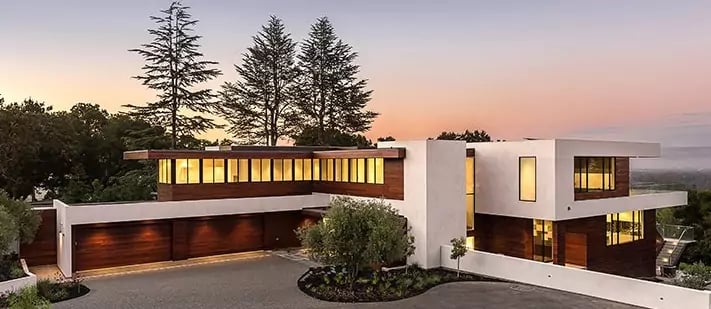
FINISHING OPTIONS
Exterior Hardwood Decking and Siding
"How long will the finish last on my decking and siding project?"
Our clients often want to know how long a particular finish will last on their hardwood project. Although we can offer an educated guess, the most accurate estimate will depend on a multitude of factors that vary significantly from site to site and even from board to board.
This page will explore the various finishing options and how they can affect the longevity of your unique decking or siding project.
DOWNLOAD THE FINISHING OPTIONS GUIDE FOR HARDWOOD DECKING AND SIDING HERE
UV INHIBITING SEALER OR COATING
Whether or not you want your hardwood decking or siding to maintain its original “like new” wood appearance or you prefer that your decking weather out to a silvery gray patina, it is best to apply a UV inhibiting sealer or coating to the surface of the hardwood.
This UV protection helps to minimize surface checking and allows the exterior woods to acclimate more slowly. This first “sunscreen” helps to protect your decking or siding and allows your wood to better adjust to their new home.
If you want to allow your hardwood siding or decking to weather to the gray, simply allow the coating to wear off naturally over time. If you want to maintain more of a “new wood’ type of look for your decking or siding, additional coatings of your chosen finish may be applied over time as the coatings show signs of age, fade or wear off. Depending on the coating you select, always follow the coatings manufacturer’s instructions for best results.
LESSONS LEARNED ABOUT DECKING AND SIDING FINISHES
Here’s what we’ve learned firsthand over the past few decades about finishing exterior hardwood decking and siding:
-
High density hardwoods like Ipe, Cumaru, Garapa, Machiche, Jatoba and others have tight, nearly non-porous, cellular structures that allow these woods to be very durable and last for decades. This same property makes it very difficult for coatings, sealers or stains to penetrate into the surface of the decking or siding wood.
-
Most traditional exterior sealers and stains do not work well (or for very long) with high density hardwoods.
-
We have tested scores of different coatings over the past twenty or so years and are still looking for the “magic coating” that will look beautiful and also last a long time. Although we have not found the magic coating yet, we will continue our search as new products and technologies become available.
-
What we have found is several coatings that work fairly well, and each of them have some benefits and limitations.
-
To best protect your hardwood investment, apply your finish on all four sides of your wood. This will help ensure the wood is evenly protected from moisture, especially for siding and low clearance decking.
-
Regardless of your initial finish selection, high density hardwoods are tough enough to let them weather to a silver gray. DOWNLOAD "HOW EXTERIOR WOODS WEATHER" for additional information.
WHAT WILL AFFECT THE FINISH OF DECKING AND SIDING

Key Factors Affecting the Longevity of a Finish On Exterior Hardwoods
-
What type of coating? (different coatings perform differently on different woods)
-
What type of hardwood? (Each hardwood species has different characteristics and will perform differently with various coatings)
-
What type of installation? Horizontal, like a deck or railing? Or vertical like fencing, siding or posts? (Horizontal surfaces take a significant beating from the elements including UV rays, rain, snow and traffic)
-
What type of environment? Marine? Desert? Forest? Arctic? Inland? (The weather and natural climate variances of different regions effect the durability and performance of different sealers)
-
If a residential deck: How much traffic and what kind of traffic activity will the deck receive? Kids? Adults? Pets? Furniture moving (chairs in and out, etc.) Dancing? Partying?
-
If a public walkway, boardwalk or dock: How much traffic and what kind of traffic will the deck receive? Skateboards? Bicycles? Vehicle traffic? For this type of application it is a good idea to apply at least an initial coat of UV inhibitor and then, if desired, allow the deck or deck to weather to a low maintenance silvery gray patina.
-
Is the site shaded or partially shaded? (typically, the more UV ray exposure, the harsher the beating of the sealer)
-
Are there other buildings or barriers that shield the sunlight at different times of the day?
-
How much sunlight does a deck or siding receive and at what time of day and year?
-
In general, the more sunlight that decking or siding is exposed to, the faster the coating will fade. Here we are not just talking about the difference between Maine and Arizona, or winter UV rays versus summer UV rays, but also the orientation of the exposure.
-
The harshest solar orientation for a deck is a southerly exposure because the sun is directly overhead and the UV rays are mercilessly beating directly down on its exposed surface all day long. The western orientation is typically the second harshest exposure for a deck.
-
With vertical applications like exterior siding, we have found the western exposure to be the harshest on the siding or coating because the sun is perpendicular to it and shows little forgiveness. The southern exposure is usually the second harshest exposure in the summer, because the sun is nearly overhead and only offers a glancing blow to the siding. Winter sunlight on that same southern wall could very well be harsher on the siding and the coating because of the angle of the UV rays and the duration of the exposure.
TEST RESULTS AND FINDINGS OF HARDWOOD FINISHES
While we are continuously testing a variety of finish manufacturers’ products, we are always on the lookout for newer and better solutions. Here are the best coatings we have found so far - along with their strengths, weaknesses and a few pointers.

Penofin® Hardwood Formula instantly delivers a beautiful and shiny appearance when it is first applied on exterior hardwood decks or siding. The Brazilian rosewood oil which Penofin uses in their formulation is uniquely effective because of its remarkably small particle size.
Unlike other finishes, Penofin successfully penetrates the surface of the high density hardwoods and provides some protection for the wood decking or siding. Penofin oil finish will enrich the look of the hardwoods and darken their appearance somewhat which helps blend the various graining and color variations that are inherent in high density tropical hardwoods. We have found that Penofin also provides some UV protection and helps the woods to acclimate more slowly and gently.
The only downside of the Penofin Hardwood Formula oil finish is the initial coat will fade out or flash off over a short period time. However, after the initial coat wears off, a second coat lasts much longer.
Apply the Penofin as directed by the manufacturer - do not over-apply this finish or it will likely get gummy. We have seen and heard from many clients that in most decking applications, Penofin typically lasts between one to two years. Some clients re-coat their deck every year, some wait longer (1-1/2 to 2 years) and others will simply allow their deck to age naturally after a period of time. The choice of appearance is truly your decision.
When you decide that it’s time for the decking or siding to be re-coated with Penofin, always clean it first and follow the instructions for a new coat. When re-coating, bear in mind that the UV rays and exposure to the elements is likely to have changed the color of the wood from its original color over time. Test a small area first to see if that’s what you like best.
"Protecting exterior hardwood decking or siding initially, is an absolute must - even if you want it to weather to a silvery gray natural tone."
High-density hardwoods like Ipe, Machiche, Garapa and Cumaru are tough and durable decking and siding options. They're also tough to finish. The tight graining of these high performance hardwood species makes finishing them a challenge. Very few finishes work. That's why we continue to test them all. It takes time. But it's worth the effort to find the best finishes for our products and clients.
After years of continuously testing all the oil finish options on decking and siding, we have found Penofin hardwood finishes to perform the best. We have been using Penofin Hardwood formula for many years. It works well. Recently we have been testing Penofin Architectural Grade finishes. They work even better.
Penofin Hardwood Formula Penetrating Oil Finish
Penofin Hardwood Formula is a penetrating oil finish. It enriches the look of hardwood decking and siding. From an appearance standpoint, Penofin Hardwood Formula shines, literally. It has a beautiful sheen that beautifies the graining and color of hardwood decking and siding.
Penofin Hardwood Formula also provides critical UV protection for your decking and siding. UV protection is essential while your exterior hardwood acclimates and seasons in its new environment. It's like putting on sunscreen before you go to the beach.
Best Penofin Finishes Tip:
For your first coat, applying Penofin hardwood finishes to all four sides of the board helps the wood 'breathe' and perform at its best.
If you wish to maintain the 'like new' wood look, simply clean and reapply a refresher coat of Penofin Hardwood Formula as needed. If you put on a maintenance coat at a later date, you only have to refinish the face of the decking or siding boards.
Many of our clients want to know how long Penofin will last on their hardwood decking or siding project. It's hard to say, because there are so many variables. The amount of sunlight, weather, traffic, exposure all factor in.
The initial coat is often called a 'sacrificial coat". With high density hardwood decking, you will likely want to re-coat your deck boards after 6 months or so. Additional coats usually last much longer. An annual re-coat of the surface of your decking boards will keep your deck looking terrific.
With high density hardwood siding, the length of time before a refresher coat is needed varies. Siding does not take the same weather punishment as decking. Generally, Penofin usually lasts much longer on siding than decking. (The western side takes a UV beating from the noon and late afternoon sun and may require an additional refresher coat of Penofin sooner than other elevations.)

Even if your ultimate goal is to allow your exterior hardwood to weather to a gray patina, a single coat of Penofin hardwood finishes are a great way to protect your investment. We believe Penofin Hardwood Formula is the best and most cost-effective way to reach this goal.
DOWNLOAD "How Exterior Wood Weathers Guide" here.
Penofin Architectural Grade Finishes
When Penofin released their new high performance Architectural Grade Finishes, we couldn't wait to test them. So we did. We tested these finishes on Ipe, Garapa, Machiche and Cumaru hardwood decking. We are very impressed with the performance of these new finishes on all four hardwood species.
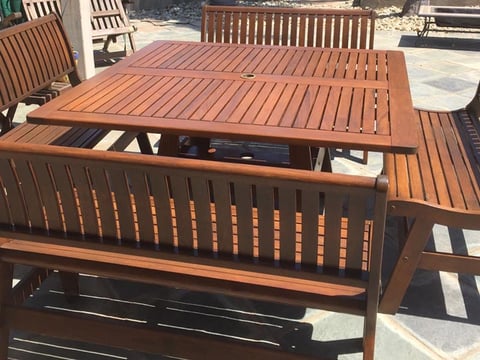
We always test new finishes against our best performing known finishes. So we tested Penofin Architectural Grade Finishes against Penofin Hardwood Formula. The new Penofin Architectural Grade finishes won! Penofin Architectural grade finishes are available in either a matte or satin finish.
Penofin Architectural Grade TMF Hardwood Finish
Transparent Matte Finish for Decks, Siding & Fences

Penofin TMF Hardwood is a transparent matte finish. This finish looked beautiful as soon as we applied it to hardwood decking. We think it is an excellent option to consider, both for hardwood decking and especially for hardwood siding.
Penofin Architectural Grade TSF Hardwood Finish
Transparent Satin Finish for Decks, Siding & Fences
Penofin TSF Hardwood is a transparent satin finish. This finish adds a slight sheen to hardwood siding or hardwood decking. We think it is a great option to consider, for decking and especially for hardwood siding.
DOWNLOAD PENOFIN ARCHITECTURAL GRADE FINISHES BROCHURE
DOWNLOAD PENOFIN ARCHITECTURAL GRADE FINISHES APPLICATION TIPS
DOWNLOAD PENOFIN ARCHITECTURAL GRADE FINISHES TECHNICAL DATA SHEET
DOWNLOAD PENOFIN ARCHITECTURAL GRADE FINISHES SAFETY DATA SHEET
Seal-Once™ Eco-Friendly Exotic Wood Sealer is another product that we have tested with some encouraging results on hardwood siding only (semi-transparent tinted products). Compared to numerous other sealers, we have found that the Seal-Once tinted products have stayed truer to their original colors for the longest periods of time in extremely harsh test conditions. Seal-Once has a matte finish and a range of commonly used tint colors are available.
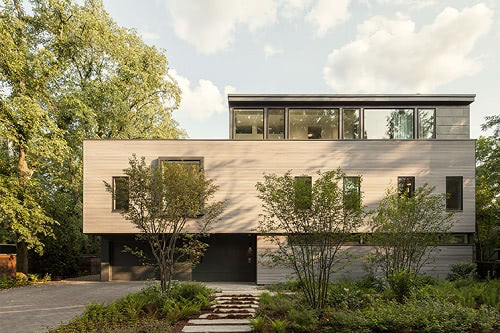
We have many architectural clients whose clients want a low maintenance finish that will immediately make their new wood look like it has gracefully aged for years. For this type of application we have had very good success with their Coastal Gray semi-transparent tinted product. The beauty of applying a gray tinted finish is that all the boards start out with a fairly uniformly grayed appearance.
While there is certainly a lot of color and grain variation from board to board, this “pre-graying” process allows designers and property owners to ‘get where they are going faster’. It has been our experience that as these tints slowly fade from UV exposure the underlying boards slowly turn their natural gray color for a relatively seamless transition to a natural patina. (An intermediate re-coat may be required along the way, depending on the orientation, amount of UV exposure and other factors.)
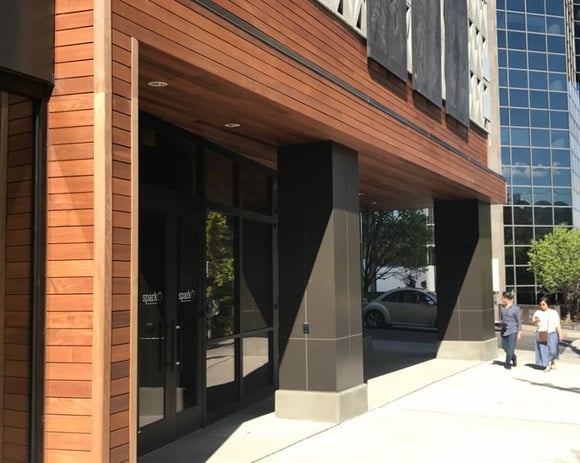
We have also tested Seal-Once with Bronze Cedar semi-transparent tint on Ipe, Garapa, Cumaru and Machiche hardwood siding and found it to provide the best protection and hold its color longer than any other products we have tested. When this product wears out or fades out it is a very simple matter of applying an additional coat according to the manufacturer’s instructions. We have found that a maintenance coat, after the siding has acclimated and been exposed to the sun and weather, is more absorbent and lasts longer than the initial 'sacrificial' coats.
"Protecting your exterior hardwood siding with a UV coating is the best way to help minimize checking during the initial on-site seasoning, period."
High-density hardwoods such as Ipe, Garapa, Machiche and Cumaru are tough and durable siding options. They're also very difficult to finish. The high density and tight graining of these high-performing hardwood species makes finishing them a tough challenge. Very few finishes actually work...and those that do, have limitations. That's why we constantly test new finishes. It takes a lot of time. But we think it's worth our time and effort. We want you to have the best finish options for our products.
One of the finishes we have tested extensively is Seal Once® NanoTech™ wood sealer with semi-transparent tints. We have found this product to perform reasonably well. For high density hardwoods, the sealer itself provides some wood protection. The semi-transparent tints, though, provide the UV protection needed for hardwood siding. During the first year of 'seasoning', exterior woods are the most vulnerable to UV rays. Protect your wood investment with the appropriate UV finish.
In our testing, we found the Cape Cod Gray semi-transparent tint and the Bronze Cedar semi-transparent tints perform better than other tint options.

Seal Once Exotic Wood Sealer with Bronze Cedar semi-transparent tint
Even if your ultimate goal is to allow your exterior hardwood siding weather to a silvery gray patina, an appropriate coating with a UV inhibiting sealer, like Seal Once with semi-transparent tints, helps protect your wood. Especially during the first season, when wood is most vulnerable. protect your investment. If you like the pre-finished look, you may re-finish it at any time as needed.
Learn more about exterior wood appearance options here:
ADDITIONAL INFORMATION FOR SEAL ONCE WOOD SEALER:
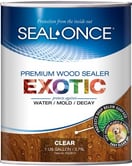 |





